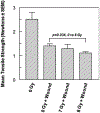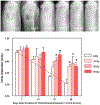Combined injury: irradiation with skin or bone wounds in rodent models
- PMID: 34233299
- PMCID: PMC11559084
- DOI: 10.1088/1361-6498/ac125b
Combined injury: irradiation with skin or bone wounds in rodent models
Abstract
A radiation combined injury is defined as an injury that occurs in the setting of irradiation, such as those expected after a nuclear accident, radiation dispersal device release (a 'dirty bomb'), or a nuclear weapon detonation. There is much research on irradiation-associated burns and their healing, but there is less known about other injuries sustained in the context of irradiation. Animal models are limited in their correlations to clinical situations but can support research on specific questions about injuries and their healing. Mouse models of irradiation with skin or bone wounds are validated as highly reproducible and quantitative. They show dose-dependent impairment of wound healing, with later recovery. Irradiation-induced delay of bone wound healing was mitigated to different extents by single doses of gramicidin S-nitroxide JP4-039, a plasmid expressing manganese superoxide dismutase, amifostine/WR2721, or the bifunctional sulfoxide MMS-350. These models should be useful for research on mechanisms of radiation dermal and osseous damage and for further development of new radioprotectors. They also provide information of potential relevance to the effects of clinical radiation therapies.
Keywords: animal models; bone wound; healing; radiation combined injury (RCI); skin wound.
© 2021 Society for Radiological Protection. Published on behalf of SRP by IOP Publishing Limited. All rights reserved.
Conflict of interest statement
Conflict of interest
J G, M W E, P W, and J S G disclose that they are inventors of patents related to this research.
Figures






Similar articles
-
Small molecule GS-nitroxide ameliorates ionizing irradiation-induced delay in bone wound healing in a novel murine model.In Vivo. 2010 Jul-Aug;24(4):377-85. In Vivo. 2010. PMID: 20668303 Free PMC article.
-
PEG-G-CSF and L-Citrulline Combination Therapy for Mitigating Skin Wound Combined Radiation Injury in a Mouse Model.Radiat Res. 2021 Jul 1;196(1):113-127. doi: 10.1667/RADE-20-00151.1. Radiat Res. 2021. PMID: 33914884 Free PMC article.
-
Endothelial Dysfunction and Impaired Wound Healing Following Radiation Combined Skin Wound Injury.Int J Mol Sci. 2024 Nov 21;25(23):12498. doi: 10.3390/ijms252312498. Int J Mol Sci. 2024. PMID: 39684207 Free PMC article.
-
Radiation combined injury: overview of NIAID research.Health Phys. 2010 Jun;98(6):863-7. doi: 10.1097/HP.0b013e3181a6ee32. Health Phys. 2010. PMID: 20445395 Free PMC article. Review.
-
Scar-free healing: from embryonic mechanisms to adult therapeutic intervention.Philos Trans R Soc Lond B Biol Sci. 2004 May 29;359(1445):839-50. doi: 10.1098/rstb.2004.1475. Philos Trans R Soc Lond B Biol Sci. 2004. PMID: 15293811 Free PMC article. Review.
Cited by
-
Effect of Taspine hydrochloride on the repair of rat skin wounds by regulating keratinocyte growth factor signal.Bioengineered. 2022 Jan;13(1):789-799. doi: 10.1080/21655979.2021.2012920. Bioengineered. 2022. PMID: 34898359 Free PMC article.
-
Understudied Populations in Radiation Exposure Research: Needs, Challenges, and Mitigation Strategies.Radiat Res. 2025 Aug 1;204(2):154-171. doi: 10.1667/RADE-24-00263.1. Radiat Res. 2025. PMID: 40462442
-
Advanced Technologies in Radiation Research.Radiat Res. 2024 Apr 1;201(4):338-365. doi: 10.1667/RADE-24-00003.1. Radiat Res. 2024. PMID: 38453643 Free PMC article.
References
-
- Mettler FA and Voelz GL 2002. Major radiation exposure—what to expect and how to respond New Engl. J. Med 346 1554–61 - PubMed
-
- Kumar N, Madhu S, Bohra H, Pandita N, Wang SSY, Lopez KG, Tan JH and Vellayappan BA 2020. Is there an optimal timing between radiotherapy and surgery to reduce wound complications in metastatic spine disease? A systematic review Eur. Spine J 29 3080–115 - PubMed
MeSH terms
Grants and funding
LinkOut - more resources
Full Text Sources
